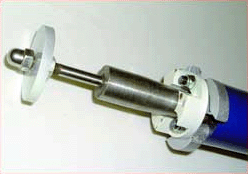Profiling Isn't Always a Nasty Word
By Tom Inglesby
 Anchoring is critical in many situations. With a little extra effort, those bolts will hold much better.
Anchoring is critical in many situations. With a little extra effort, those bolts will hold much better.
When a straight hole is drilled in masonry units for an expanding anchor, the anchor uses pressure to grip the wall of the hole. In some situations, that might not be adequate. Anyone who has had an anchor come lose or fail due to chipping or cracking masonry at the drilled point can understand there must be a better way.
Now there is a novel technique available to provide greater security and safety with anchor holes. Using a standard rotary drill or concrete coring machine, a specially designed diamond drill bit can create a profiled hole with cavities at various depths along the hole's shaft, allowing anchors to expand into the areas rather than only apply pressure against the hole's wall. Where wind, seismic events or engineering call for even better security, profiled holes can be used with a variety of non-traditional anchors to give much better performance.
The Profiler bit from Cintec, a global company with North American offices in Washington, D.C., and Nepean, Ontario, is designed to work with a complete anchoring system from Cintec but can, according to Robert Lloyd-Reese, also be used with standard expanding anchors. Lloyd-Reese, Cintec North America's COO, doesn't recommend that approach, however.
"The bit works best when it's applied with the full Cintec system, obviously," he says. "While we can't recommend using common anchors, they will work in an emergency; they just won't take advantage of the profiled hole as well as our system will."
The Profiler bit can be used with pre-drilled holes created with rotary drills or hammers or holes cast into concrete. Anywhere an anchor is needed and the material is cementious, a profiled hole could add reliability and security to the anchoring process. This includes setting equipment on concrete when the gear vibrates a lot, high side anchoring of mast climbers and scaffolding, securing block, stone and brick fa?ade material to poured or panel concrete, and especially in restoration work where century-old material can afford minimal anchoring potential.
In operation, a standard straight hole is drilled to a depth appropriate to the task and material, for instance a half-inch hole drilled four inches into a concrete panel. The Profiler bit is mandrel-shaped to create the desired profile and a diamond-banded "drilling tube" that does the actual profile coring. The mandrel is inserted into the hole so the tip, with a small washer and nut set, is bottomed. Then the core sleeve is placed over the mandrel shaft and turned by the drill. As the sleeve descends the length of the mandrel, the profile of the mandrel causes the diamond segments to expand, forcing the cutting material outward against the wall of the material, grinding the profile. The core tube accommodates the mandrel and keeps it centered while the expanding diamond "blades" work outward to expand the hole into the desired profile.
When used with a multi-part profile, such as those with repeated bulges along the length, the camming action of the mandrel forces the cutting blades out and retracts them when appropriate.
The Cintec anchoring system has various cementious material anchors, including one that causes bulges of mortar at each point in the profiled hole where a cavity has been created. This product was developed in the United Kingdom and used in the post-fire restoration of Windsor Castle.
A steel rod wrapped in a fabric "sock" is inserted into a predrilled hole in the masonry. Once in place, extra-fine grout is pumped into the end. As the anchor fills, the milk grout is forced through the mesh, creating a chemical bond between the anchor and the substrate.
"One of the best things about this system is that the material is cementious, not epoxy-based," explains architect Michael Zemsky. "The most interesting part is that the nylon sock expands to fill the cavity until it is completely wedged in."
Zemsky specified Cintec anchors on the Essex County New Courts Building and Jail in Newark. The 1966 building's limestone curtain wall panels had separated from the structure, causing damage so pervasive and severe that the building was, in Zemsky's words, "one accident away from catastrophic failure."
Using this expanding mortar-filled anchor creates a dual connection: it expands into the cavity formed by the profiling drill, and the seeping mortar bonds chemically with the substrate.
About the Author
Tom Inglesby is a San Diego-based freelance writer whose work has appeared in numerous online and print publications. He is the winner of the Construction Writers Association's 2002 Boger Award for Special Reports.


















